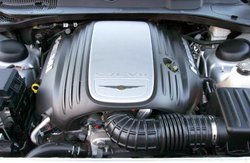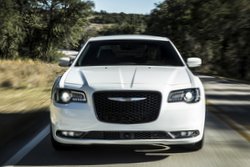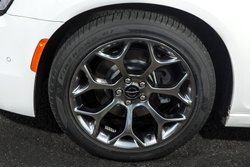The Past Meets Present Fuel Efficiency
Chrysler’s 2017 300 Series sedans are certainly too new to be called classics, but they bristle with touches from the past: classic proportions—long hood, short rear deck and a dramatic profile; a grille reminiscent of the mid-1950s; spacious, luxurious appointed cabin; rear wheel drive; and, of course, the legendary Chrysler Hemi V-8 engine.
When the 300 Series was first introduced in the ’50s, Chrysler’s “Letter Series†cars were large, premium automobiles. The Chrysler name was associated with luxury and their offerings played in the same league as Cadillac and Lincoln. But unlike the originals, today’s 300 four-door sedans compete for business by clashing with rivals that are in a different league than the past—the Chevrolet Impala, Ford Taurus, Toyota Avalon and Nissan’s Maxima. One of Chrysler’s distinctions is that it’s the only one in this group offering two things prized in old and new big cars–a V-8 engine and all-wheel drive, though you can’t get the two together.
The tradition of offering 300 Series cars with different levels of luxury and powerplants continues today. Four core models make up the 2017 Chrysler 300 line, ranging from a well-equipped mainstream full-size sedan in the 300 Limited to the luxurious 300C Platinum. The 300S offers a sportier alternative for the younger crowd, while the 300C balances on a near-luxury beam.
A Higher MPG Option
Just two engines are offered in the 2017 Chrysler 300. The base engine is a 3.6-liter Pentastar V-6 that earns 19/30/23 mpg city/highway/combined on the EPA cycle, or 18/27/21 mpg with all-wheel drive. Other than the Avalon Hybrid, this is the top fuel economy for a full-size car.
A step up to a 5.7-liter Hemi V-8, available on 300S, 300C, and 300C Platinum gets an EPA-estimated mileage quote of 16/25/19 mpg. As noted–a one of a kind, so best-of-breed by default.
Since neither of the two engines comes close to the fuel economy numbers of the cars that we normally review, readers might question why we would write about a V-8 powered car with middling mpg numbers. The simple answer is, we cover green technologies, improvements to fuel efficiency and alternative powertrains for all classes of vehicles–not just those with the very highest fuel efficiency.
According to Experian Automotive, which specializes in collecting and analyzing automotive data, Americans own an average of 2.28 vehicles per household, and more than 35 percent of households own three or more cars. And it is likely that one of those three cars doesn’t have stellar fuel economy.
What The Heck Is A Hemi Engine?
Hemi is a trademark name by Chrysler (now FiatChrysler Automobiles) that refers to the engine’s hemispherical combustion chamber’s design. The name reflects the concept of a domed cylinder head and the top of the piston enclosing a space that approximates a half of a sphere (hemi+sphere+ical), although in practice it is generally less than half.

Chrysler developed their first experimental hemi engine for the Republic P-47 Thunderbolt fighter aircraft in 1945. The automaker applied their military experience with the hemispherical combustion chamber to their first overhead-valve V-8 engine, released under the name FirePower, not “Hemi,†and produced a second-generation version before ending production in the early ’70s.
The 2005 Chrysler 300C model marked the return of the legendary Hemi engine to the company’s lineup. Compared to the original, the new Hemi doesn’t have a pure hemispherical combustion chamber. Much of the bowl area of the combustion chamber was filled in to encourage the fuel-air mixture to stir itself prior to ignition. The chamber is shallower than past Hemis so the top of the piston is nearly flat.
Even though it isn’t a genuine Hemi, this current 5.7-liter V-8 engine packs the powerful punch of 363 horsepower and 396 pounds-feet of torque. So how can this high-performance V-8 in a car that weighs more than 4,000 pounds deliver 16 mpg in the city and 25 mpg on the highway? Engine technology called cylinder deactivation seamlessly turns off fuel consumption in four cylinders when V-8 power is not needed, such as highway cruising. Add in an eight-speed automatic transmission, and you have a recipe for big engine fuel efficiency.
The transimission is operated via a rotary knob. Select S, and the throttle tightens up, the downshifts get more aggressive, gears are held longer, and the transmission will hang out in lower gears than normal. Choose the paddle shifters while in S, the transmission will go full manual and won’t revert back to auto.
Designed In Detroit
Swagger, presence, boldness—whatever you want to call it, the 2017 Chrysler 300 has it. It’s a look that stands out from its peers, even though its basic shape launched more than a decade ago. It remains a handsome car in the more traditional Detroit mold with plenty of chrome trim.
This second generation Chrysler 300 received a front and rear refresh in 2015. The grille was enlarged with a different mesh-type pattern, and headlights were redesigned, with C-shaped LED daytime running lights for instant notoriety. To complement the new grille, the lower air dam was redesigned with chrome accents and fresh LED fog lamps. On the backside, the rear fascia was visually widened with polished exhaust tips enlarged and pushed to the corners; while new LED tail lamps with an illuminated halo added a flash of elegance.
The profile remains the square-shouldered, brawny, yet sleek look it has been since 2012’s redesign, but now has a slightly less-flashy, more buttoned-down look.

In the 1950s the Letter Series always signified Chrysler’s premium automobile and does so today. The 2017 300 is sure to impress with its interior design and furnishings. Trim and accent pieces are high quality, and the car is put together solidly. One attractive feature is the inclusion of standard Nappa leather seats, which is an especially premium material that’s usually an upgrade even in luxury models.
Faithful to its raison d’etre, few competitors can match the Chrysler 300 when it comes to passenger accommodations. The 300 can comfortably seat five people. The back seat offers more than 40 inches of leg space, so even taller passengers can stretch out. Full-size adults can fit in the rear comfortably, which you can’t do in most modern five-passenger cars. Front seats are equally roomy, and the driver’s seat is a great place to work with features like a power-adjustable steering wheel and heated/ventilated seats. The 300’s trunk gives you 16.3 cubic feet of space, enough for a whole family’s luggage or a foursome’s golf bags.
For 2017 the Chrysler 300 received a thorough round of upgrades, focusing on the electronics suite. Among the updates are a new fourth-generation Uconnect infotainment system with smartphone integration, Apple CarPlay and Android Auto connectivity, an upgraded 8.4-inch touchscreen that now recognizes multi-touch and swipe gestures. The Uconnect touchscreen interface is one of my favorites, pairing large buttons and crisp graphics with a logical menu structure.
Standard features include dual-zone automatic climate control, a six-speaker audio system, satellite radio, Bluetooth phone connectivity and audio streaming, two USB ports, the Uconnect infotainment system and a rearview camera. Optional features include a sunroof, a choice of premium audio systems, navigation and adaptive headlights.
On the safety side, available are forward collision warning, automatic emergency braking, lane departure warning, lane keep assist, automatic high beams and adaptive cruise control.
When The Hemi Meets The Road
Looking back to 2005 when the Chrysler 300 was revived, there’s one thing that hasn’t changed about the car—how it drives. It still feels like a big imposing car. The big, long dashboard rolled out ahead into the long, wide hood giving a sense of length to the car, and the wide, short windshield seemed to stretch the car from one side of the lane to the other. From behind the steering wheel, it imparts a feeling of privilege generally reserved for much more expensive cars.

The 300S was a soothing respite to the bustle of noisy city traffic—nicely soundproofed, luxuriously appointed and a pleasure to drive. This isn’t a cut and dart kind of car to gain a couple spots in traffic, and you sure as heck can’t pull a U-turn on narrow city streets. Parallel parking? Only if you are proficient.
The big Chrysler moved fast off the line, and since it’s rear drive, there’s no torque steer to contend with. The Hemi has a lot of good torque and lots of power right off idle. You can waste a set of tires without even trying.
On the highway, the 300 drove like a big American car should; stable and confident. There was just enough engine, road, and wind noise to keep me connected with the road. Comfortable ride quality is one of the 300’s strong selling points. Regardless of the road surface—raised slabs, tilted slabs, pot holes, dips, exaggerated expansion joints—the 300 was always calm and collected. I particularly like the suspension tuning, which is a nice balance between the taught European offerings and the somewhat softer Japanese setups.
Handling in the 300S was more about comfort and ride quality than performance—this is, after all, a large sedan. When the road turned twisty, I could feel the 300’s size, although the standard electric power steering made light work of taking the turns. The 300 was not a ballerina, but it wasn’t a lumbering bear.
After a week in the 2107 Chrysler 300S, the 294 miles comprised considerably more highway miles than city miles. That could explain the 23.8 combined mpg—not exactly a gas guzzler after all.
In The Marketplace
The base 2017 Chrysler 300 Limited trim with the V-6 engine starts at $33,435 including destination charges, the priciest 300 trim, the 300C Platinum with the Hemi V-8, clocks in at $46,865. Our Bright White 300S with optional sunroof, cooled performance front seats, appearance package and bigger brakes stickered at $42,995.

With a starting price nearly $5,000 lower than the cheapest Chrysler 300, the Chevrolet Impala is worth a look. While it earns better fuel economy, it eschews many of the 300’s luxury features and no V-8 engine is offered.
Toyota’s Avalon comes the closest to the 300’s luxury appointments, but it’s front-wheel drive only and offers only four- and six-cylinder engines. Over at Nissan, the Maximum is more fun to drive with slightly better fuel mileage than the 300, however, the interior lacks the premium look and feel of the Chrysler and there is no V-8 engine available.
That big car feel can be charming, especially with the Hemi V-8 under the hood. In this era of crossovers and hybrids, the 2017 Chrysler 300S redefines old school cool. The 300 is best for those who crave V-8 muscle and need plenty of room and comfort to haul a family. If that description fits you, you need to test drive the 2017 Chrysler 300 with Hemi power.
Related Stories You Might Enjoy:
Road Test: 2016 Chevrolet Impala
Road Test: 2016 Nissan Maxima
Road Test: 2016 Toyota Avalon
Disclosure:
Clean Fleet Report is loaned free test vehicles from automakers to evaluate, typically for a week at a time. Our road tests are based on this one-week drive of a new vehicle. Because of this we don’t address issues such as long-term reliability or total cost of ownership. In addition we are often invited to manufacturer events highlighting new vehicles or technology. As part of these events we may be offered free transportation, lodging or meals. We do our best to present our unvarnished evaluations of vehicles and news irrespective of these inducements.
Our focus is on vehicles that offer the best fuel economy in their class, which leads us to emphasize electric cars, plug-in hybrids, hybrids and diesels. We also feature those efficient gas-powered vehicles that are among the top mpg vehicles in their class. In addition, we aim to offer reviews and news on advanced technology and the alternative fuel vehicle market. We welcome any feedback from vehicle owners and are dedicated to providing a forum for alternative viewpoints. Please let us know your views at publisher@cleanfleetreport.com.

6 thoughts on “Road Test: 2017 Chrysler 300 S Hemi V-8”